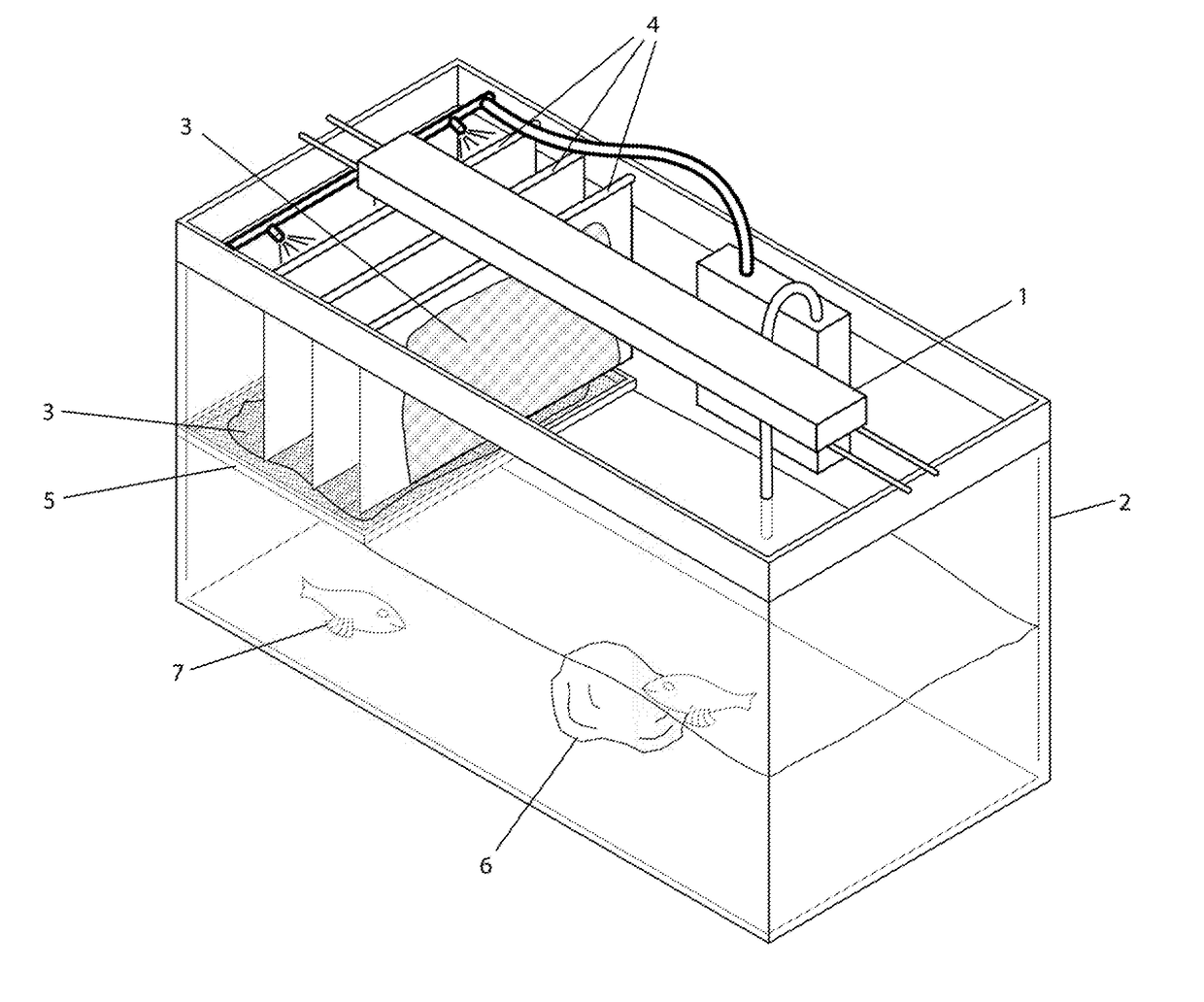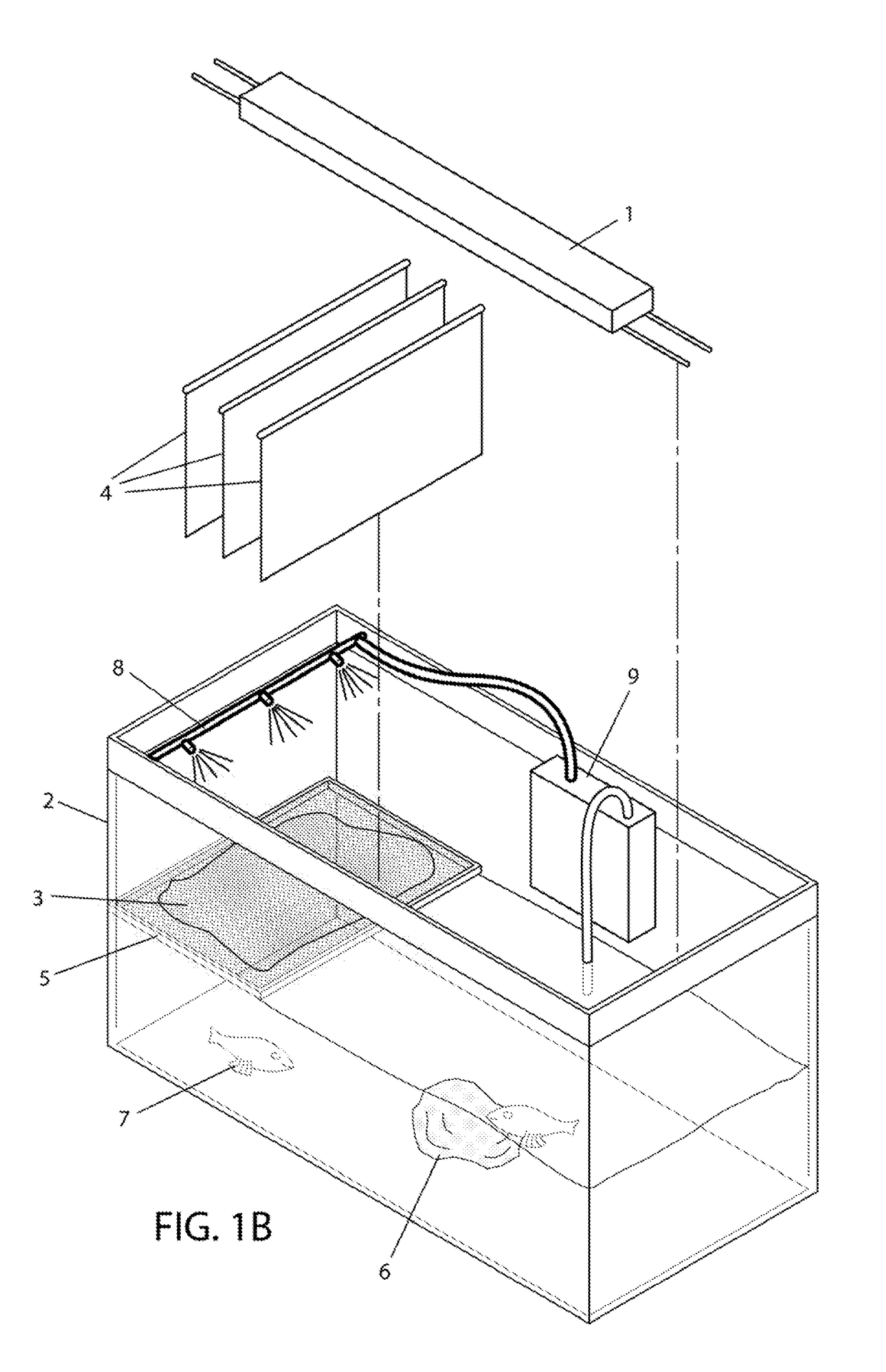Algae Farm
a technology of algae farm and algae, applied in the field of algae farm, can solve the problems of not revealing the use of plates or water pumps, not producing enough oil at a practical scale, and not revealing the use of plates or culturing filamentous alga
- Summary
- Abstract
- Description
- Claims
- Application Information
AI Technical Summary
Benefits of technology
Problems solved by technology
Method used
Image
Examples
example 1
[0099]This example illustrates construction and use of a small scale system of the present teachings.
[0100]This system is depicted in use in FIG. 1A and FIG. 1B. The present inventor sanded three 8 inch by 10 inch acrylic plates (4) (FIG. 1B) and then suspended them from PVC pipes using curtain rings so that the plates extended approximately half way down into a 30 gallon fish tank (Grofizz, LLC, Austin, Tex.) (2) (FIG. 1A, FIG. 1B); the pipes rest on the rim of the fish tank. The fish tank was filled with reverse osmosis (RO) water to just below the surface of the plates. A turtle pump (9) (FIG. 1B) (Turtle Filter FX-350, EXO TERRA®, Mansfield, Mass.) was mounted on the back of the tank with a suction hose in the bottom of the tank and a spray hose above the algal plates to extract water from the bottom of the tank, through the filter, and into the spray bar (8) (FIG. 1A, FIG. 1B) made out of PVC pipes that had holes punched to form spray bars that continuously provided a flow of w...
example 2
[0101]This example describes the construction and use of a 100 gallon scale system.
[0102]Drawings of this example are provided in FIG. 2A-2G. The present inventors constructed a frame using white PVC pipe arranged as a square at top with four legs extending from each corner of the square to the floor. Two 18 in×24 in acrylic plates were prepared by sanding the surfaces until rough and then fitting the edges with red and blue LEDs (12) (FIG. 2A, FIG. 2E). These prepared plates (4) (FIG. 1B, FIG. 2A) were then suspended from the frame into a first 100 gallon tank (2a) (FIG. 2A, FIG. 2B, FIG. 2C, FIG. 2F, FIG. 2G) (RUBBERMAID®) by V-shaped metal bars (14) (FIG. 2B, FIG. 2D) attached to the plates wherein the ends were allowed to rest on the PVC pipe frame (20) (FIG. 2A, FIG. 2B). The tank was filled with water such that the lower end of the plates rested just above the water's surface. A 650 gallons per hour (GPH) water pump submerged in the bottom of the primary tank was used to pump ...
example 3
[0103]This example describes a CO2 scrubber of the present teachings.
[0104]A 12 foot by 20 foot by 100 foot first greenhouse or room is fitted with a steel frame and a 4 foot deep water tank, 4 foot by 8 foot frosted acrylic plates are suspended from the ceiling. The greenhouse is connected by a pipe to an industrial source of CO2 such as a power plant flue. The pipe further includes a control valve. A CO2 sensor is affixed to the top of the greenhouse wall approximately 1 foot from the ceiling. An O2 sensor is affixed to the wall approximately 2 feet below the CO2 sensor. The CO2 sensor is configured to close the valve connected to the CO2 source if the CO2 sensor detects CO2 concentration at or above a threshold level. The O2 sensor is configured to open the valve connected the CO2 source if the O2 sensor detects O2 concentration reaching a threshold level. These two sensors are configured such that as the room fills with CO2, the valve closes, thereby limiting CO2 concentration i...
PUM
| Property | Measurement | Unit |
|---|---|---|
| wavelength ranges | aaaaa | aaaaa |
| wavelength ranges | aaaaa | aaaaa |
| wavelength ranges | aaaaa | aaaaa |
Abstract
Description
Claims
Application Information
 Login to View More
Login to View More - R&D
- Intellectual Property
- Life Sciences
- Materials
- Tech Scout
- Unparalleled Data Quality
- Higher Quality Content
- 60% Fewer Hallucinations
Browse by: Latest US Patents, China's latest patents, Technical Efficacy Thesaurus, Application Domain, Technology Topic, Popular Technical Reports.
© 2025 PatSnap. All rights reserved.Legal|Privacy policy|Modern Slavery Act Transparency Statement|Sitemap|About US| Contact US: help@patsnap.com



